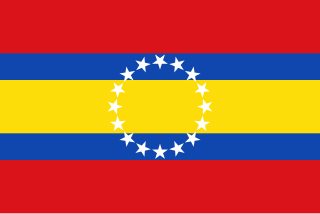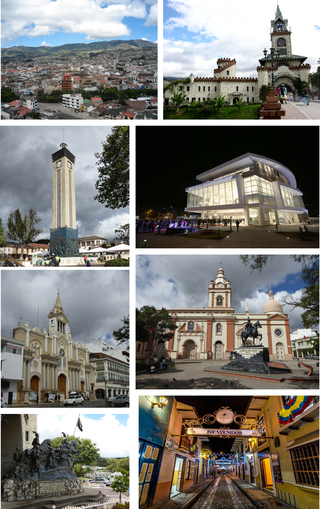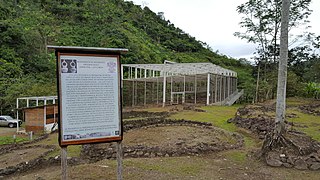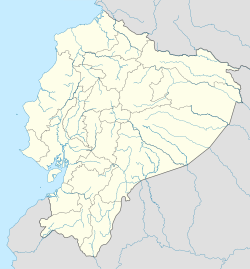
Ecuador is divided into 24 provinces. The provinces of Ecuador and their capitals are:

Loja Province is one of 24 provinces in Ecuador and shares its southern border on the west with El Oro Province, on the north with El Azuay, and on the east with Zamora-Chinchipe. Founded on its present site in 1548 by Captain Alonso de Mercadillo (Spanish), the site had been previously moved and rebuilt from La Toma due to earthquakes. It also is named as "Cuxibamba Valley", from the Quichua language, which means the "Smiley Valley".

Zamora Chinchipe, Province of Zamora Chinchipe is a province of the Republic of Ecuador, located at the southeastern end of the Amazon Basin, which shares borders with the Ecuadorian provinces of Azuay and Morona Santiago to the north, Loja and Azuay to the west, and with Peru to the east and south. The province comprises an area of approximately 10,559 km² and is covered with a uniquely mountainous topography which markedly distinguishes it from the surrounding Amazonian provinces. Zamora-Chinchipe is characterized and largely identified by its mining industry; indigenous ethnic groups with a rich archaeological legacy; its biodiversity; and its niche and tourist attractions, which include a number of waterfalls well-noted for their beauty. The province takes its name from the bureaucratic fusion of the Zamora and Chinchipe cantons. The provincial capital is the city of Zamora.
Jonacatepec de Leondro Valle is a city in the Mexican state of Morelos. The city serves as the municipal seat for the surrounding municipality of the same name. The municipality reported 15,690 inhabitants in the year 2015 census.

Loja, formerly Loxa and fully City of the Immaculate Conception of Loja, is the capital of Ecuador's Loja Province. It is located in the Cuxibamba valley in the south of the country, sharing borders with the provinces of Zamora-Chinchipe and other cantons of the province of Loja. Loja holds a rich tradition in the arts, and for this reason is known as the Music and Cultural Capital of Ecuador. The city is home to two major universities.

Valle de la Pascua is the capital city of the autonomous municipality of Leonardo Infante, Guárico, Venezuela. The city is located in the central plains of Venezuela and was founded on February 25, 1785, by Father Mariano Martí. Along with Zaraza, Calabozo and San Juan de Los Morros, Valle de la Pascua is one of the most important cities in the state of Guárico and the most important economically. The vicinity of the city was the scene of the Battle of Valle de la Pascua in February 1814.

Santo Domingo de los Colorados or simply known as Santo Domingo, is the biggest canton in the Santo Domingo de los Tsáchilas Province, after La Concordia officially became part of the province on May 31, 2013. The canton is named after its seat, the town of Santo Domingo. The canton partially occupies the Toachi river basin. The Toachi river flows into the Daule river.

Pedro Domingo Murillo is a province in the Bolivian La Paz Department. It was created on January 8, 1838, with the name Cercado and on October 17, 1912, during the presidency of Eliodoro Villazón, its name was changed in honor of Pedro Domingo Murillo, protagonist of the revolution of June 16, 1809.

Zamora de Hidalgo(Spanish pronunciation: [saˈmoɾa de i'dalɢo]) is a city in the Mexican state of Michoacán. The 2010 census population was 141,627. making it the third largest city in the state. The city is the municipal seat of Zamora Municipality, which has an area of 330.97 km2 and includes many other smaller communities, the largest of which is Ario de Rayón. The municipality's population is around 186,102, which makes it the second most populous urban area in the state.

Zamora is a city in southeastern Ecuador; it is the capital of Zamora-Chinchipe province and the seat of Zamora Canton. Zamora is the principal and most populous city in Zamora-Chinchipe. It is located in the Oriente region ath base of the eastern portion of the Andes mountains in Ecuador, at 970 m above sea level, at the convergence of the Zamora, Bombuscaro and Jamboé rivers.

Zamora is a canton in the Zamora-Chinchipe Province of Ecuador. It was named after Zamora city, the provincial capital and head of the canton of the same name.

Loja Canton is located in the southeast of the Province of Loja bordering the Podocarpus National Park and the Province of Zamora-Chinchipe in the east and south, and the cantons of Saraguro in the north, Catamayo, Gonzanama, and Quilanga in the west. The principal city is Loja which is also the provincial capital. It is also home to Vilcabamba, the "Valley of Longevity."

Espíndola is a canton in the Province of Loja Ecuador. It is located in the south-east, bordered by the cantons of Quilanga and Calvas, the province of Zamora-Chinchipe and the country of Peru. It covers an area of 632 km2 at an altitude of 1720 m, with a population of 19,213. The average temperature is 19.9 °C.

Vega de Tera is a municipality located in the province of Zamora, Castile and León, Spain. According to the 2004 census (INE), the municipality has a population of 470 inhabitants.

Santo Domingo de los Tsáchilas is a province in the Republic of Ecuador, created in October 2007 from territory previously in the province of Pichincha.

Palanda Canton is a canton of Ecuador, located in the Zamora-Chinchipe Province. Its capital is the town of Palanda. Its population at the 2001 census was 7,066.

Yantzaza Canton is a canton of Ecuador, located in the Zamora-Chinchipe Province. Its capital is the town of Yantzaza. Its population at the 2001 census was 14,552.
Pachamama Raymi is a ceremony held annually on August 1 in Ecuador and Peru.

Ecuador is a nation in northwest South America known as the Republic of Ecuador. Hundreds of thousands of kinds of plants and animals can be found there as a result of the diversity of its four zones. There are roughly 1640 bird species there. Along with the 4,500 kinds of butterflies, there are also 345 reptiles, 358 amphibians, and 258 mammals. Ecuador is regarded as one of the 17 nations with the highest concentration of biodiversity on Earth. The majority of its animals and plants are found in 26 state-protected areas. It also provides gastronomy, a range of cultures and customs, and historical attractions like Quito.

Santa Ana (La Florida) is an important archaeological site in the highlands of Ecuador, going back as early as 3,500 BC. It is located in the Palanda Canton, just to the north of its regional capital of es:Palanda, in the Zamora-Chinchipe Province of Ecuador.

















